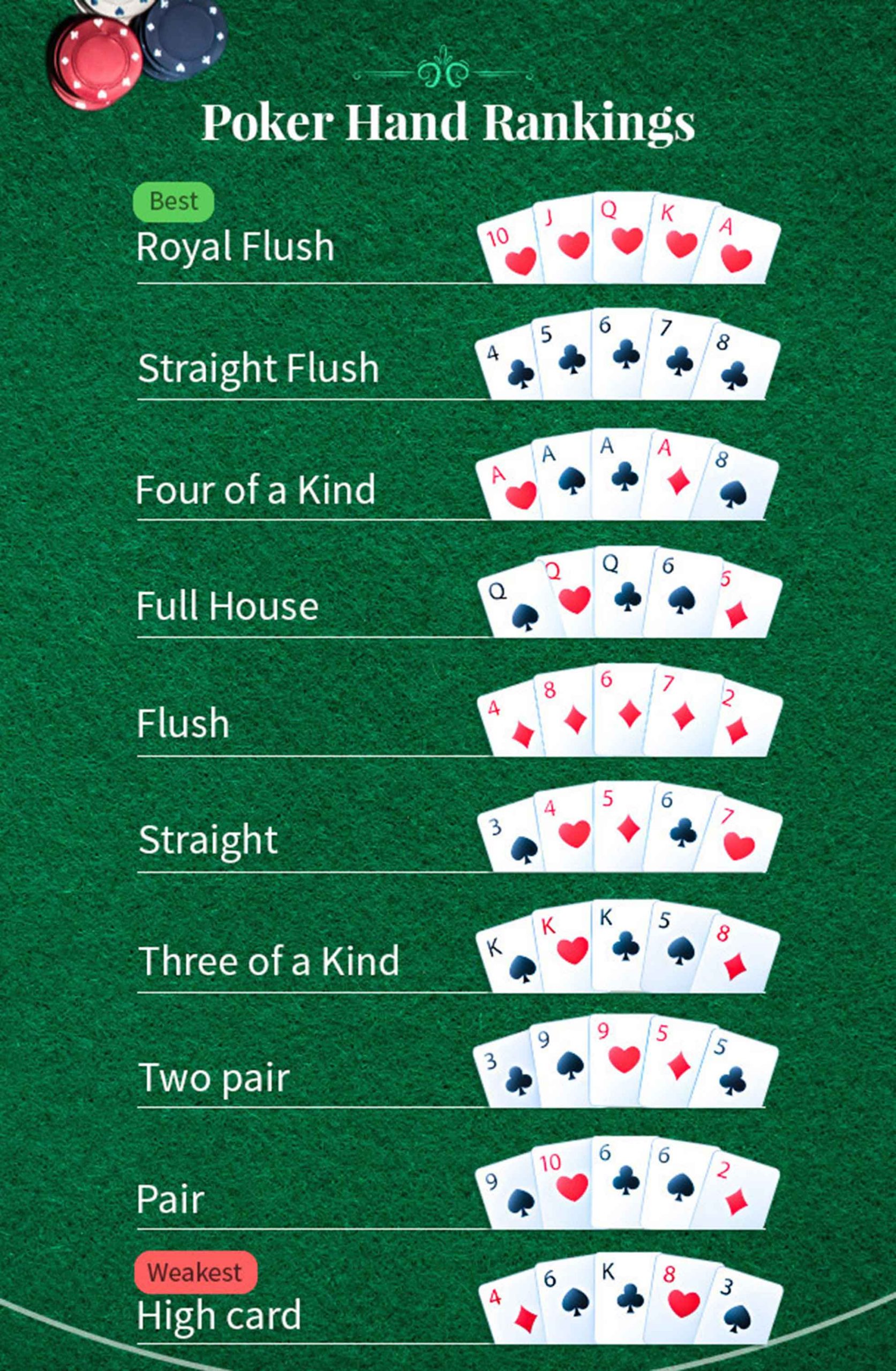
The shimmering allure of green felt, the rattle of chips, and the clink of a glass to celebrate a well-played hand—there’s something uniquely enthralling about the world of poker. Whether you’re attracted to its intricate psychology, the allure of beating the odds, or the primal appeal of head-to-head competition, poker is a game that never fails to captivate. While many are familiar with the phrase “you have to know when to hold ’em and when to fold ’em,” the rules of poker are a bit more complicated. This guide aims to demystify the nuances of how to play poker, especially for new players.
The Basics: Understanding the Poker Table and Cards
Poker is a versatile game that can be played with varying numbers of players. Generally, it’s played on a poker table with 2–10 participants. Your mission is to either have the best hand or bluff well enough to convince others you do.
Best casino slots in 2022 USA

300% Welcome Bonus |

Choose 100% Bonus |

Take 100% Welcome Bonus |

100% free spins |
At the heart of any poker game play is the standard 52-card deck. No wild cards or jokers in most variations. These cards are the building blocks of potential poker hands that will determine victory or defeat.
Cards are ranked from two to Ace, with Ace being the highest. Each suit—Hearts, Diamonds, Clubs, and Spades—holds equal value in poker rules, a fact that newcomers often overlook.
Before any cards are dealt, two players must post “blinds” — forced bets to start the pot. This ensures there’s something to play for in each hand, keeping the game dynamic and compelling.
Each player is dealt two “hole cards” face-down. These are your secret weapons, the cards you’ll use to build a hand that’s hopefully superior to your opponents’. These cards are essential for how to play poker for beginners, as they shape your strategy.
As the game progresses, community cards are dealt face-up in the center of the table. They’re public, meaning they contribute to every player’s hand. Understanding how these relate to your hole cards is crucial to mastering poker basics.
Poker Hands: The Hierarchical Structure
High Card
If no one has any of the following hands, the highest card wins. It’s the most basic form of winning, but it’s also the weakest poker hand you can have.
Pair
Two cards of the same rank, for instance, two Kings. Simple, but powerful if played right. This is one of the more common hands of poker.
Two Pair
A step above a single pair. This hand includes two different pairs, like two Aces and two 7s. Recognizing these poker hand rules can help you decide when to bet high or fold.
Three of a Kind
Three cards of the same rank. Not as elusive as other hands, but definitely stronger than a pair. Knowing this poker hand guide can help you weigh your options.
Straight
Five consecutive cards of any suit. Remember, Ace can count as the lowest card, but not in the middle of a straight. Mastering this poker hand rule can significantly elevate your game.
Flush
Any five cards of the same suit. The ranks don’t matter here; it’s all about the suit. Again, this is an essential element in poker rules hands.

The Intricacies of Betting: When to Hold’em and When to Fold’em
After blinds are posted and hole cards are dealt, the first round of betting begins. Here, poker rules for beginners suggest that if you have a weak hand, it might be best to fold.
After the first three community cards are revealed, another betting round occurs. Understanding the poker hand guide helps you know whether to bet, check, or fold at this stage.
The turn is the fourth community card, and the river is the fifth. These rounds have their own betting rounds and are crucial for how to play poker with cards effectively.
In each round, you have the option to check, bet, raise, or fold. Your strategy here is vital, as it could lead to winning or losing the pot. Knowing how to poker well involves mastering these options.
Going “all-in” means putting all your chips into the pot. It’s the ultimate high-risk, high-reward play and can dramatically shift the dynamics of the game. Poker how to guide often recommend understanding table dynamics before going all-in.
Some games have a fixed limit, pot-limit, or are no-limit. These dictate how much you can bet or raise, and understanding these limits is essential for playing poker effectively.
Mastering the Art of Bluffing
Bluffing is pretending you have a better hand than you actually do. It’s a core component of poker strategy, and mastering it is vital for poker playing.
Good times to bluff include when you’re in a late position, when the board indicates you might have a strong hand, or when you’re up against fewer players. How do you play poker effectively involves knowing when to bluff and when not to.
A significant aspect of bluffing involves reading your opponents. If they’re weak or hesitant, a well-timed bluff can force them to fold. Being able to read opponents is a crucial skill in poker rules simplified.
Paying attention to opponents’ body language can give you cues about their hands. This is an advanced skill but crucial for poker playing effectively.
While it’s essential to read others, make sure you’re not giving anything away yourself. Keeping your body language neutral is part of how to play poker game successfully.
A successful bluff can make a weak hand win. Mastering bluffing not only helps you win, but also adds a level of depth and excitement to the game.
Understanding Poker Strategies: Beyond the Rules
One of the most straightforward strategies in poker for beginners is to play strong hands and fold weak ones. Your starting hand will give you a strong indication of how to proceed in the game.
Being in a “late” position can be advantageous, as it gives you the benefit of seeing how many other players act before you make your move. How to play poker simple involves understanding your table position.
This refers to the ratio between the current size of the pot and the cost of a contemplated call. Poker explained through pot odds can help you make more educated decisions.
Observing how other players behave can offer valuable insights into their strategy and hand quality. Are they aggressive or cautious? These cues can guide your actions, enriching your understanding of how to play poker.
One of the foundational poker basics is learning how to calculate risk versus reward. Knowing the current size of the pot, your odds of completing a drawing hand, and the likely actions of your opponents all factor into this.
Poker isn’t just about individual hands; it’s about your long-term game. Knowing when to take risks and when to play conservatively can be the difference between winning and losing over the long run. Grasping this nuance is crucial for understanding how to play poker for beginners.

The Role of Psychology: Reading the Table
The quintessential element that comes to mind when people think of poker playing is maintaining a neutral expression. A “poker face” isn’t just for show; it’s a strategic necessity for hiding your intentions.
Humans are creatures of habit. As you play more, you’ll notice recurring behavior patterns. Being able to predict a player’s actions based on past moves is a useful poker rule.
One of the lesser-discussed poker game rules is emotional control. Anger, frustration, or even excessive elation can impair your judgment, affecting how well you play poker.
Poker is a social game, and mastering the social dynamics at the table can give you an edge. How players interact with each other can offer cues about their hands and their strategy.
Your gut feeling can be a useful guide, but it should not replace logical decision-making. Balancing intuition with statistical odds is the hallmark of a seasoned player and should be your ultimate goal in learning how to play poker with cards.
The World of Online Poker: How it Changes the Game
In the era of the internet, playing poker has moved from smoky backrooms to online platforms. These offer unique advantages and challenges, from multi-tabling options to the absence of physical tells.
Online games are generally faster. This pace can be both a boon and a bane, as quick decisions might lead to mistakes. However, the rapid tempo can also be exhilarating and a fresh take on simple poker rules.
In online poker, your opponents can’t see you, making traditional psychology less effective. However, digital actions like the speed of play can serve as tells for the observant player.
Online platforms offer a wide variety of poker styles, from Texas Hold’em to Omaha to Seven-Card Stud. This variety can be a treasure trove for someone keen on poker games rules.
Many online platforms offer bonuses, loyalty points, and other incentives, which you won’t find in traditional casinos. These can give your game a boost and offer a different angle on how to play poker for beginners.

The Importance of Etiquette: Unwritten Poker Rules
One of the first things to learn about how to play poker is the importance of quick decision-making. When you’re slow to make your moves, you not only test the patience of the other players, but also disrupt the natural flow of the game. Respecting other players’ time is an essential yet frequently ignored rule of poker.
Poker may be a fiercely competitive game, but a friendly demeanor goes a long way. Keeping the table atmosphere congenial ensures that the game is enjoyable for all participants. This isn’t just about good sportsmanship; it’s an essential poker instruction that can even give you a psychological edge.
When engaged in poker playing, it’s vital to keep an eye on whose turn it is. Failing to do so can lead to skipped turns or actions taken out of sequence, creating confusion among both the players and the dealer. Knowing when it’s your turn and what actions are allowed are vital poker game rules.
In the world of poker how to play and win might be your primary focus, but knowing when to stop is just as crucial. Whether you’re ahead or facing a string of losses, understanding when to step away is a sign of a mature player. This is an unwritten poker rule that applies across all types of poker games.
By observing these unwritten poker rules, you’re not just being polite; you’re also creating a fair and enjoyable environment for everyone. These aspects of etiquette are integral to the game, yet are often overlooked, even by those who think they know how to play poker well.
Conclusion
Poker isn’t just a game of luck; it’s a complex ballet of strategy, psychology, and skill. Whether you’re learning how to play poker easy or diving deep into advanced strategies, the game offers something for everyone. It’s a never-ending journey of learning and adaptation. So shuffle up and deal—the table is set for you to become the next poker star.
Best casino slots in 2022 USA


300% Welcome Bonus |

Choose 100% Bonus |

Take 100% Welcome Bonus |

100% free spins |
